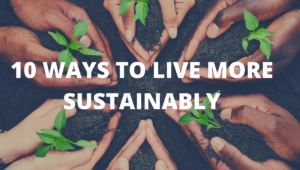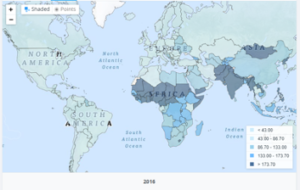10 WAYS TO LIVE MORE SUSTAINABLY
 Are you hoping to make some changes in your life? We all know that making sustainable lifestyle choices is best for our planet, but it’s also good for our budgets and health. So, if you’re ready to become a little more environmentally friendly, check out these 10 tips. And remember, small actions can lead to significant results!
Are you hoping to make some changes in your life? We all know that making sustainable lifestyle choices is best for our planet, but it’s also good for our budgets and health. So, if you’re ready to become a little more environmentally friendly, check out these 10 tips. And remember, small actions can lead to significant results!
Understand What We Actually Need:
We all want to live sustainably, but it is hard to know where to start. One problem is that the experts can’t agree on what “sustainability” means. They disagree on whether it requires us to;
- Stop adding CO2 to the atmosphere;
- Stop using fossil fuels;
- Whether it’s enough just to slow down the growth in our use of them; or even just
- Slow down the growth in our population.
This blog does not try to provide a precise definition of sustainability. That is impossible: we wouldn’t need any advice if we knew precisely what we wanted. Instead, this essay describes some of the apparent paths toward sustainability — paths ignored or neglected by most writers. Some of you answered your query about how to write my essay on the suitability of earth with different aspects!
Meanwhile, we can increase the reliability of our research by checking out the “Mortality Rate” attributed to household and ambient air pollution, age-standardized female/male (per 100,00 population). The most recent data we found is from 2016.

Source: WHO, Global Health Observatory Data Repository
- Set Priorities in Consumption Behavior:
- An individual has two choices in their pattern behaviours: necessary and discretionary. Necessary consumption is food, water, shelter, and transportation. These kinds of consumption are not avoidable. You can not sacrifice your basic necessities.
- Discretionary consumption is everything else. You can discard your high-end leisure or lavish activities, use of alcohol and tobacco, number of visits to restaurants and other entertainment-related expenses. Here you have a choice of setting your priorities. It comes after your basic necessities. The less discretionary consumption you have, the smaller your environmental footprint will be.
- Proper Reduction of Waste:
- Reduce, reuse, and repair; think about reusing and recycling things.
- Buy less unnecessary stuff.
- Repair things that are broken instead of throwing them away;
- Use what you already have before you buy more;
- Compost organic waste rather than sending it to landfills;
- Reuse cloth bags instead of buying new plastic ones every time you go shopping.
- Travel sustainably:
- Consider walking and cycling in urban areas, riding public transport, or carpooling when possible.
- Buy efficient, low-carbon vehicles when you must travel by car.
- Walk, use a bike, skateboard, or rollerblade whenever possible. This is the most prominent and straightforward way to reduce your carbon footprint.
- Many people feel they don’t have the time to walk or ride a bike. Still, with a bit of creative thinking, you can find ways to incorporate physical activity into your daily routine, so you aren’t sacrificing your health or productivity at all.
- Make Your Home More Environment-Friendly:
Make sure your home is energy efficient;
- Insulate your walls, floors, and ceiling;
- Choose double-glazing for your windows;
- Use efficient appliances;
- Use low-energy lighting;
- Turn off lights when not in use;
- Make sure your home is well ventilated during winter months;
- Buy local produce to save on transportation costs.
- Organic Cropping and Farming:
- If you have access to land, grow some of your own food.
- Plant a garden and fresh harvest produce,
- Join a CSA (community-supported agriculture) or buy from farmer’s markets and CSAs.
- Buy organic foods where you can; shop at farmers’ markets.
- Raising animals or raising bees, getting your own honey, making dairy products, etc. You’ll be healthier, and it will save you money.
- Conserve Energy:
- Turn off lights when you leave the room;
- Unplug electronics when not in use;
- Turn down the heat in winter and the AC in summer (if you can);
- Drive less by consolidating trips and using public transit; walk or bike when possible.
- Save water by fixing leaky faucets and toilets,
- Take shorter showers and turn off the faucet while brushing teeth, etc.
- Collect rainwater for irrigation or other uses (such as drought-resistant plants, etc.)
- Reduce Clutter:
- Get rid of unnecessary things by selling them on Craigslist, donating them to charity, or recycling them. It will feel refreshing to free yourself from unwanted stuff.
- Make sure every item you own serves at least two purposes. For example, combine a flashlight with a power bank so that you never have to throw away batteries again.
- Practice Recycling and Less Plastic:
- Reduce the amount of rubbish you produce by recycling (reducing your use of plastic),
- Composting your food scraps and using second-hand materials when possible.
- Recycling uses less energy than producing things from scratch while composting turns organic waste into valuable fertilizer.
- Do not buy bottled water when tap water is fine; throw away plastic bottles as they pile up in landfills;
- Reduce your use of paper towels;
- Use handkerchiefs instead of tissues;
- Drive less, walk more; buy local produce whenever possible; it has lower “food miles”; switch.
- Invest in Sustainable Businesses:
- Support businesses that contribute to building a sustainable society, such as making products from recycled materials or using renewable energy sources for manufacturing their products.
- Sustainability supports long-run growth potential by creating opportunities for innovation and differentiation that help companies stay ahead of the competition over time.
- Be Selective in Your Purchases:
Be more selective about what you buy and consume only things that add value to your life (instead of buying cheap stuff just because it’s on sale). Only keep things that are healthy, pocket-friendly, and eco-friendly.
- You can buy second-hand goods in good condition whenever possible at yard sales, thrift stores, flea markets, etc.
- Rather than buying new items, you don’t need clothes, books, toys, etc.
- This is a very affordable way to get quality goods rather than throwing them away when they are worn out or broken in some way after a few months or years of use.
- After all, they have already been made, and it’s just a matter of someone else using them before you do (and saving them from going into a landfill somewhere).
Conclusion: It’s easy to get caught up in the rat race of your everyday life and forget that you can make changes to live a more sustainable lifestyle. The good news is that you’re not on your own. Countless resources are available in print, online, and on social media pages to help you find ways to live more sustainably. Now go out there and make your planet and yourself proud!
Author’s Bio:
Jack Franklin has been a writer for the past 10 years. He completed his Bachelors Degree in Software Engineering from NY University. He has written for prestigious websites like Perfect Essay Writing and my work has been recognized worldwide.


Sorry, the comment form is closed at this time.